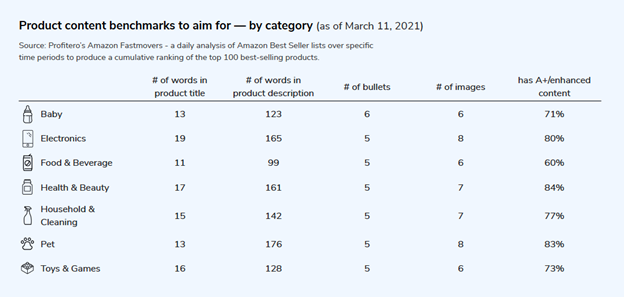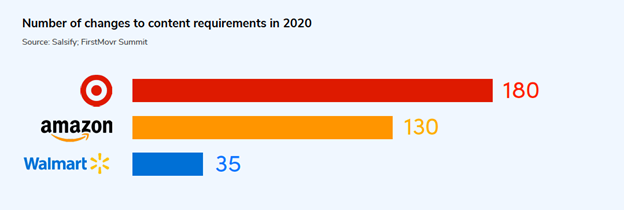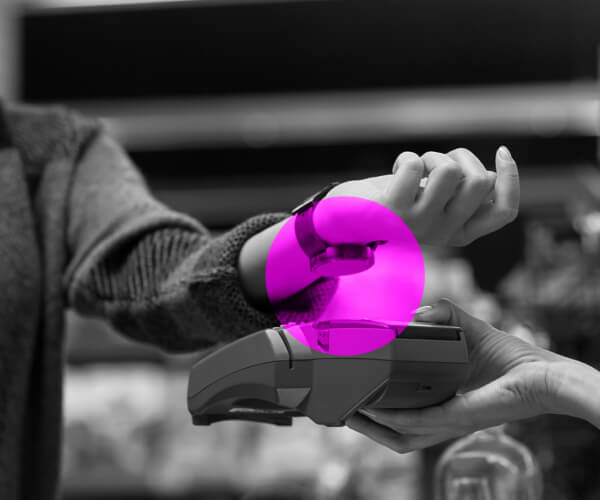E-retailers keep changing the PDP rules!
PDP rules change all the time across categories and retailers. How can you optimize for sales, no matter the marketplace?
The retail world is decidedly digital, and our clients have shared what a challenge it is to manage product data content at E-commerce retailers and ensure that it is compliant, effective, and helps to drive sales. We hear you! And we have chronicled your challenges in our e-book that addresses Ten Pain Points in E-commerce to Overcome.
Challenge #2 is that the rules keep changing!
As we mentioned in our last post, it might be logical that every e-retailer has its own rules relating to how they expect manufacturers to participate in their digital platforms.
OK, once you accept that challenge, then it should be relatively simple to understand the restrictions and requirements with which Product Detail Pages must be populated with text and visual content to be compliant. (Mind you, compliance doesn’t always equal effectiveness in conversion to sales!)
Sorry . . . no such luck. The rules (and they are extensive) differ category by category, and they change a lot!
Let’s consider categories; depending on whether your product is a sofa, or a bottle of sulfate-free shampoo, or a bag of dry cat food for mature diabetic felines, what you can (and in certain cases, must) add to your Product Detail Page is different.
It might be perfectly reasonable. The “size” or dimensions of a sofa, in inches or centimeters, is an essential detail for a consumer making a purchase choice, especially when the sofa purchase is for a living room versus, say, a doll’s house. But the “size” of shampoo is measured in ounces, or maybe the dimension of the bottle if it has to fit on a bathroom shelf, and dry cat food (measured in pounds) comes in bags that are small, medium, and “multi-cat household” large!
The details of ingredients for shampoo relating to functional benefits (“is really safe for color-treated hair?”) are different from the details that are warnings or claims for pet products.
And all of these will differ SKU by SKU.
Then let’s take categories like Cosmetics, and specifically mascara. Images on the PDP may relate to the product and packaging or the product bought as part of a bundle with other eye makeup products and accessories. But it can also relate to the application of the product and even the final sultry result of the mascara applied to well-made-up lashes.
Then there is the whole matter of Quantity. Numbers of popsicles to a pack versus how many packs to purchase can result in some pretty hilarious mix-ups ups when the shopper heads to the digital check out unless YOU are the consumer! (Check back in a few weeks when we talk about Challenge #7 for some sad but true examples!)
Overall, the rules for product images deal with general tech requirements related to legibility on various viewing technology (number of pixels required to be viewable on mobile, as an example). Virtually none of the platforms that e-marketers at manufacturers must utilize to populate E-commerce pages provide ANY guidance for effectiveness of visuals beyond rudimentary compliance with different and ever-changing rules. Much more importantly, the overall guidelines for images in the PDP provide nothing that indicates whether shoppers will see and be influenced enough by the images to hit the all-important “add to cart” button.
In March of 2021, Product Data Management software provider Profitero issued a report on “The ROI for Improving Content,” in which they revealed some guidelines and content benchmarks to aim for in Product Detail Pages to be a best seller on the digital shelf:

(Quite revealing of the significant category complexity . . .. and this was just for Amazon!)
Note that this referenced # of images broken out by category, but nothing in terms of guidance on what might make those images effective. Oh, and in that same report, Profitero warned that yes, the rules keep changing!
“You can’t just “set it and forget it” on the digital shelf. Why? Because things outside your direct control can cause content compliance issues. For example, on sites like Amazon, third-party (3P) sellers can change your content if they win the Buy Box. And just because you send the correct content to a retailer doesn’t mean they will display it or update it in their systems.
On top of this, retailers often change their product content requirements, which can catch brands off-guard. For example, Target changed its content requirements 180 times in 2020 alone, according to Salsify — that’s almost 4X the number of changes in the prior two years combined.”

So, on top of conveying compelling product benefits, e-marketer teams must be ever vigilant to enormous complexity, changing rules, and potential deficiencies in product content that can inadvertently but directly impact E-commerce sales. Now that is indeed a challenge!
As Adam Sandler, Sr. Director, Category Activation & Digital Product (E-commerce/digital) – Bountiful Company put it: “Keeping our content fresh, relevant, and compliant is a huge, ongoing challenge.”
The Solution? Flash.PDP™!
Behaviorally is the leading digital partner to help brands drive shopper growth.
Knowing these challenges exist for our clients on E-commerce teams who want to win in digital retail, we developed a solution that leverages visual recognition AI, our extensive database of shopper marketing content, our unique behavioral framework, and decades of category expertise.
Introducing Flash.PDP – an always-on alert system to identify and optimize product images on the PDP that will convert to sales and drive shopper growth. It addresses category and retailer-specific metrics that provide easy, efficient ways to monitor and optimize images that will lead to increased sales.
To learn more, contact a Behaviorally digital retail expert today here.
